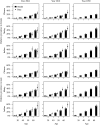Forecasting the burden of type 2 diabetes in Singapore using a demographic epidemiological model of Singapore
- PMID: 25452860
- PMCID: PMC4212579
- DOI: 10.1136/bmjdrc-2013-000012
Forecasting the burden of type 2 diabetes in Singapore using a demographic epidemiological model of Singapore
Abstract
Objective: Singapore is a microcosm of Asia as a whole, and its rapidly ageing, increasingly sedentary population heralds the chronic health problems other Asian countries are starting to face and will likely face in the decades ahead. Forecasting the changing burden of chronic diseases such as type 2 diabetes in Singapore is vital to plan the resources needed and motivate preventive efforts.
Methods: This paper describes an individual-level simulation model that uses evidence synthesis from multiple data streams-national statistics, national health surveys, and four cohort studies, and known risk factors-aging, obesity, ethnicity, and genetics-to forecast the prevalence of type 2 diabetes in Singapore. This comprises submodels for mortality, fertility, migration, body mass index trajectories, genetics, and workforce participation, parameterized using Markov chain Monte Carlo methods, and permits forecasts by ethnicity and employment status.
Results: We forecast that the obesity prevalence will quadruple from 4.3% in 1990 to 15.9% in 2050, while the prevalence of type 2 diabetes (diagnosed and undiagnosed) among Singapore adults aged 18-69 will double from 7.3% in 1990 to 15% in 2050, that ethnic Indians and Malays will bear a disproportionate burden compared with the Chinese majority, and that the number of patients with diabetes in the workforce will grow markedly.
Conclusions: If the recent rise in obesity prevalence continues, the lifetime risk of type 2 diabetes in Singapore will be one in two by 2050 with concomitant implications for greater healthcare expenditure, productivity losses, and the targeting of health promotion programmes.
Keywords: Adult Diabetes; Demographics; Simulation; Statistical Methods.
Figures



References
LinkOut - more resources
Full Text Sources
Other Literature Sources
Medical
